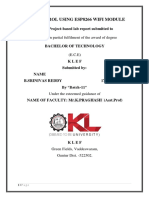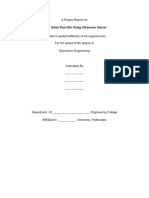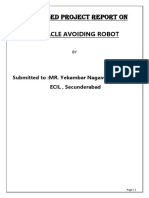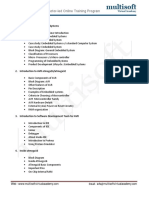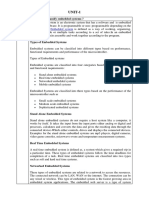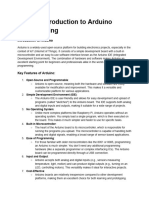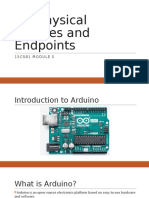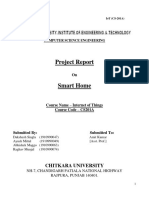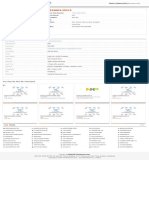Abstract
Abstract
Uploaded by
Vallabh JoshiCopyright:
Available Formats
Abstract
Abstract
Uploaded by
Vallabh JoshiOriginal Description:
Copyright
Available Formats
Share this document
Did you find this document useful?
Is this content inappropriate?
Copyright:
Available Formats
Abstract
Abstract
Uploaded by
Vallabh JoshiCopyright:
Available Formats
Home automation using arduino
ABSTRACT
The project focus on the automation of electrical home equipments. Automation is
achieved using advanced microcontroller along with necessory sensor.The project
involves electronic door lock, light control and temperature controls.Home security is
essential for occupants convenience and protection. At entry point the system should
secured this is the main purpose to design this system.This paper aims to develop a
low-cost means of home security system using sensors like motion sensor, PIR sensor
etc
The working of our light control system is based on the amount of luminous
energy in the environment at that moment of time. Depending upon the light intensity
at that instant the lighting of the lighting system is adjusted. The embedded main
board including the Microcontroller chip, memory(flash), and communication port are
used as a processing module for the input that we get from peripheral devices
(LDR).Application of such a system can be implemented in workstations, park lights,
street lighting system, head lights of automobiles and much more.
INTRODUCTION
Dept.ECE\K.L.S VDRIT HALIYAL
Home automation using arduino
Home automation system is getting popular and widely used in a lot of houses
worldwide. It has tons of advantages to users even more to the handicapped and/or
elderly users in which it will make it easier for them to control their home appliances.
Home automation systems can be labeled to two medium in which how it is connected
and they are either wired or wirelessly connected. The main difference between these
two kinds is that home appliances are linked wirelessly a central controller if it a
wireless home automation system. On the other hand, the appliances are connected to
a central controller if the medium use wired communication method. Wireless system
had been introduced in order to dispose of wired communication among home
appliances. Arduino based, Bluetooth based home automation will be applied.
Home automation is computerization of the home, housework or household action.
Home automation may incorporate a control unit for controlling of lighting, HVAC
(warming, ventilation and aerating and cooling), machines, and different frameworks,
to give enhanced accommodation, solace, better energy saving ,productivity and
security. The idea of home Automation has been around for quite a while and items
have been available for a considerable number of years, however nobodys
arrangement has gotten through to the standard yet. Home computerization for the
elderly and debilitated can give expanded personal satisfaction to persons who may
generally need parental figures or institutional consideration. It can likewise give a
remote interface to home apparatuses or the automation system itself, through phone
line, remote transmission or the web, to give control and observe and monitor.
ARDUINO
Arduino is open source physical processing which is base on a microcontroller board
and an incorporated development environment for the board to be programmed.
Arduino gains a few inputs, for example, switches or sensors and control a few
multiple outputs, for example, lights, engine and others. Arduino program can run on
Dept.ECE\K.L.S VDRIT HALIYAL
Home automation using arduino
Windows, Macintosh and Linux operating systems (OS) opposite to most
microcontrollers frameworks which run only on Windows. Arduino programming is
easy to learn and apply to beginners and amateurs.
Arduino is an instrument used to build a better version of a computer which can
control, interact and sense more than a normal desktop computer. It's an open-source
physical processing stage focused around a straightforward microcontroller board, and
an environment for composing programs for the board.
Arduino can be utilized to create interactive items, taking inputs from a diverse
collection of switches or sensors, and controlling an assortment of lights, engines, and
other physical outputs. Arduino activities can be remaining solitary, or they can be
associated with programs running on your machine (e.g. Flash, Processing and
Maxmsp.) The board can be amassed by hand or bought preassembled; the open-
source IDE can be downloaded free of charge.
Focused around the Processing media programming environment, the Arduino
programming language is an execution of Wiring, a comparative physical computing
platform.
Dept.ECE\K.L.S VDRIT HALIYAL
Home automation using arduino
WHY ARDUINO
There are numerous different microcontrollers and microcontroller platforms
accessible for physical computing. Parallax Basic Stamp, Netmedia's BX-24,
Phidgets, MIT's Handyboard, and numerous others offer comparative usefulness.
These apparatuses take the chaotic subtle elements of microcontroller programming
and wrap it up in a simple to-utilize bundle. Arduino additionally rearranges the
methodology of working with microcontrollers; moreover it offers some advantages
for instructors, students, and intrigued individuals:
Inexpensive - Arduino boards are moderately cheap compared with other
Dept.ECE\K.L.S VDRIT HALIYAL
Home automation using arduino
microcontroller boards. The cheapest version of the Arduino module can be amassed
by hand, and even the preassembled Arduino modules cost short of what $50.
Cross-platform - The Arduino programming runs multiple operating systems
Windows, Macintosh OSX, and Linux working frameworks. So we conclude that
Arduino has an advantage as most microcontroller frameworks are constrained to
Windows.
Straightforward, clear programming method - The Arduino programming
environment is easy to use for novices, yet sufficiently versatile for cutting edge
customers to adventure as well. For educators, its favorably engaged around the
Processing programming environment, so understudies finding ways to understand
how to program in that environment will be familiar with the nature of Arduino.
Open source and extensible programming. The Arduino program language is available
as open source, available for development by experienced engineers. The lingo can be
reached out through C++ libraries, and people expecting to understand the specific
purposes of different interests can make the leap from Arduino to the C programming
language on which it is based. Basically, you can incorporate C code clearly into your
Arduino programs.
Open source and extensible hardware - The Arduino is concentrated around Atmel's
Atmega8 and Atmega168 microcontrollers. The plans for the modules are circulated
under a Creative Commons license, so experienced circuit designers can make their
own particular interpretation of the module, extending it and improving it. slightly
inexperienced customers can build the
breadboard variation of the module remembering the finished objective to perceive
how it capacities and save money.
Dept.ECE\K.L.S VDRIT HALIYAL
Home automation using arduino
Dept.ECE\K.L.S VDRIT HALIYAL
You might also like
- The Reconstruction and Its Effects - US History OutlineNo ratings yetThe Reconstruction and Its Effects - US History Outline11 pages
- Water Level Indicator Mini Project ReportNo ratings yetWater Level Indicator Mini Project Report22 pages
- Vlsi Ecad Lab Manual 2nd Cycle Exp 2019No ratings yetVlsi Ecad Lab Manual 2nd Cycle Exp 201925 pages
- Micro Controller Lab Manual 2022 SchemeNo ratings yetMicro Controller Lab Manual 2022 Scheme97 pages
- Arm 7 Based Theft Control, Accident Detection & Vehicle Positioning SystemNo ratings yetArm 7 Based Theft Control, Accident Detection & Vehicle Positioning System3 pages
- Design of A Sensor-Based Adaptive Smart Home System Using NXP ARM Cortex-M3No ratings yetDesign of A Sensor-Based Adaptive Smart Home System Using NXP ARM Cortex-M34 pages
- Ece Mini Project On Embedded Password Based Security Door Lock System100% (2)Ece Mini Project On Embedded Password Based Security Door Lock System45 pages
- EC3552 VLSI and Chip Design Lecture Notes 1No ratings yetEC3552 VLSI and Chip Design Lecture Notes 1297 pages
- Optical - Communication - LAB - MANUAL 22222 3No ratings yetOptical - Communication - LAB - MANUAL 22222 338 pages
- Department of Electronics and Communication Engineering: Course Outcomes Mapping Co With Po and PsoNo ratings yetDepartment of Electronics and Communication Engineering: Course Outcomes Mapping Co With Po and Pso64 pages
- Automatic Temperature & Brightness ControllerNo ratings yetAutomatic Temperature & Brightness Controller67 pages
- Lab Based Project Report On: Obstacle Avoiding RobotNo ratings yetLab Based Project Report On: Obstacle Avoiding Robot27 pages
- Water Level Controller of Overhead Tanks Using Water Level Sense - Project ReportNo ratings yetWater Level Controller of Overhead Tanks Using Water Level Sense - Project Report29 pages
- Digital Voltmeter Using PIC MicrocontrollerNo ratings yetDigital Voltmeter Using PIC Microcontroller7 pages
- UNIT 3 - Introduction To Arduino ProgrammingNo ratings yetUNIT 3 - Introduction To Arduino Programming27 pages
- Catalog of NIMS Creep Data Sheets: Science and Technology of Advanced MaterialsNo ratings yetCatalog of NIMS Creep Data Sheets: Science and Technology of Advanced Materials31 pages
- The United Nations and It's Organs: by Ankit Kashyap 7 SemesterNo ratings yetThe United Nations and It's Organs: by Ankit Kashyap 7 Semester11 pages
- Guide For Cross-Border Electricity SalesNo ratings yetGuide For Cross-Border Electricity Sales19 pages
- Six Sigma Methodology in Telecom Sector For Quality ImprovementNo ratings yetSix Sigma Methodology in Telecom Sector For Quality Improvement6 pages
- Legacy V Design Report: Varun Talathi, Ajinkya Belsare, Aditya Chivate, Abhilash ChopadeNo ratings yetLegacy V Design Report: Varun Talathi, Ajinkya Belsare, Aditya Chivate, Abhilash Chopade8 pages
- Electrical Design and Aspects of Hvac: Unit - 3: Installation of Heating, Cooling, and Refrigeration SystemsNo ratings yetElectrical Design and Aspects of Hvac: Unit - 3: Installation of Heating, Cooling, and Refrigeration Systems41 pages
- Period Close Procedure For Accounts Receivables Oracle R12No ratings yetPeriod Close Procedure For Accounts Receivables Oracle R128 pages
- Chapter 3-CP For Armed Conflict SituationNo ratings yetChapter 3-CP For Armed Conflict Situation23 pages
- The Reconstruction and Its Effects - US History OutlineThe Reconstruction and Its Effects - US History Outline
- Arm 7 Based Theft Control, Accident Detection & Vehicle Positioning SystemArm 7 Based Theft Control, Accident Detection & Vehicle Positioning System
- Design of A Sensor-Based Adaptive Smart Home System Using NXP ARM Cortex-M3Design of A Sensor-Based Adaptive Smart Home System Using NXP ARM Cortex-M3
- Ece Mini Project On Embedded Password Based Security Door Lock SystemEce Mini Project On Embedded Password Based Security Door Lock System
- Department of Electronics and Communication Engineering: Course Outcomes Mapping Co With Po and PsoDepartment of Electronics and Communication Engineering: Course Outcomes Mapping Co With Po and Pso
- Lab Based Project Report On: Obstacle Avoiding RobotLab Based Project Report On: Obstacle Avoiding Robot
- Water Level Controller of Overhead Tanks Using Water Level Sense - Project ReportWater Level Controller of Overhead Tanks Using Water Level Sense - Project Report
- Catalog of NIMS Creep Data Sheets: Science and Technology of Advanced MaterialsCatalog of NIMS Creep Data Sheets: Science and Technology of Advanced Materials
- The United Nations and It's Organs: by Ankit Kashyap 7 SemesterThe United Nations and It's Organs: by Ankit Kashyap 7 Semester
- Six Sigma Methodology in Telecom Sector For Quality ImprovementSix Sigma Methodology in Telecom Sector For Quality Improvement
- Legacy V Design Report: Varun Talathi, Ajinkya Belsare, Aditya Chivate, Abhilash ChopadeLegacy V Design Report: Varun Talathi, Ajinkya Belsare, Aditya Chivate, Abhilash Chopade
- Electrical Design and Aspects of Hvac: Unit - 3: Installation of Heating, Cooling, and Refrigeration SystemsElectrical Design and Aspects of Hvac: Unit - 3: Installation of Heating, Cooling, and Refrigeration Systems
- Period Close Procedure For Accounts Receivables Oracle R12Period Close Procedure For Accounts Receivables Oracle R12






